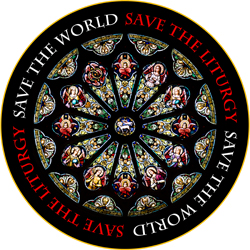I urge you to go immediately to this blog and read "Little Things"
http://www.danielmitsui.com/hieronymus/index.blog/1797457/little-things/
I suggest you save the post, and re-read it before heading to church Friday afternoon for what I'm told used to have the paradoxical nick-name, "Mass of the Pre-Sanctified."
We make (not-very-funny) jokes about the past 40 years in the desert, but how would we last through 251 years in the desert?
I have been thinking about the denigration and deliberate suppression of myriad devotions, and of two of its consequences in particular: the impoverishment of Catholic identity and tradition, and the deformation of the Mass as non-liturgical events and practices are shoe-horned into it.
Mr Mitsui eloquently, heart-breakingly, speaks of the first, reminding the sneerers of the sometimes dire need for the "Little Things."
(Note: the practice of e-fumi will ring a bell for anyone who has read C S Lewis's science fiction trilogy.... or anyone who reads of some of the interrogation methods used on Muslim detainees, I suppose.)
A taste:
In 1614 an edict proscribing Christianity was issued. In this edict, Japan was described as "the county of gods and of Buddha". It condemned the Christian religion as the opponent of Confucian morality, Buddhist law, and the Shinto way - the amalgam that constitutes the Japanese religious temperament. Not only did it demand that daimyo send any foreign missionaries in their domain to Nagasaki for deportation, but it also ordered the destruction of all their churches. The native Christians, too, were compelled to recant their faith... Those who did not comply were subject to "divine punishment"... The practice of e-fumi (trampling on Christian images) began around 1629 as a means of detecting Christians by observing who would shrink from the act... The Christians lived under constant threat of persecution, according to which harassment and torture were deemed successful if they induced apostasy. Some punishments designed for this purpose were the retraction of employment (which inevitably led to begging or starvation), dismemberment, branding, water torture, lowering the victim's body into the boiling sulfur springs of Unzen, and the ana-tsurushi, or headfirst suspension in a pit of excrement until the victim either recanted or died.
-- Christal Whelan, Introduction to The Beginning of Heaven and Earth
...Being from the region of Nagasaki, my ancestors presumably include countless cross-tramplers. For several years, as a spiritual exercise, I have imagined myself in their place during the commemoration of the Lord's Passion on Good Friday; I pretend that the cross I kiss is a fumi-e; that I am expected to desecrate it and that my family and I will be tortured and thrown into a volcano if I do not. This is how I understand what it means to venerate a sacred image.
The Kakure Kirishitan - the "hidden Christians" of Japan - were able to practice a crypto-Christianity disguised as Buddhism; they attended the temples like their neighbors, but secretly fasted from meat on Fridays and gathered to pray the Rosary. They had no priests, and thus no Mass, but they baptized children in celebrations disguised as birthday parties. They kept statues of Buddhist saints that resembled Christian ones, and collected rocks whose shapes suggested the Virgin Mary. Some communities guarded the small catechisms and devotional books that the missionaries had disseminated, but most relied on memorized, orally transmitted prayers in garbled Latin. Some families kept pious trinkets that the missionaries had given their ancestors - medals not much different from those now sold in Catholic bookstores for 25 cents each. The Kakure Kirishitan hid these in their homes and handed them down through the generations...
A mentality ... that informs defenders [of the iconoclasm in VCII's wake] today ... old Catholicism with its religious trinkets and Friday meatfasts and bits of memorized Latin was regarded as childish - as "minimalist" and "rules-oriented", or even as distracting from the more important things with which a "mature Christian" should be occupied....
Sometimes religious trinkets and Friday meatfasts and bits of memorized Latin are all they have to sustain their faith for centuries, at enormous risk and sacrifice. In Japan, this needed to be enough, and it was enough; enough that on 17 March 1865, after 251 years of brutal persecution, a tiny population was able to approach missionary priest Bernard Petitjean and say: The heart of all of us here is the same as yours. ...
This iconoclasm was motivated not by the zeal of a false religion, but, as Martin Mosebach wrote, by angst and pusillanimity.... because their souls were far too small for such "little" things.
Subscribe to:
Post Comments (Atom)




1 comment:
Of course, this posting made me think of Shusako Endo's book, "Silence." It also reminded me of a historical novel I read about the persecution of Catholics in the Tudor period. Imagine if everything religious that you take for granted just disappeared? And the Mass was to be found only rarely and at great peril?
Post a Comment